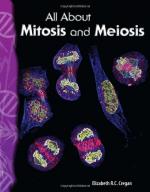|
This section contains 1,263 words (approx. 5 pages at 300 words per page) |

|
Nondisjunction is the failure of two members of a homologous pair of chromosomes to separate during meiosis. It gives rise to gametes with a chromosomal content that is different from the norm. The consequences of this are usually quite severe, and a number of clinical conditions are the result of this type of chromosome mutation.
The Mechanism of Nondisjunction
Homologous chromosomes are virtually identical chromosomes that occur in pairs, one member inherited from each parent. Humans have forty-six chromosomes, or twenty-three homologous pairs. In normal meiosis, homologous chromosomes pair up and, by attachment to the spindle fibres, become aligned at the cell equator. Prior to the first meiotic division, the members of each homologous pair migrate to opposite poles of the cell by means of the pulling action of the spindle fibers. This ensures that, upon completion of meiosis, each gamete will contain one copy of every chromosome...
|
This section contains 1,263 words (approx. 5 pages at 300 words per page) |

|


